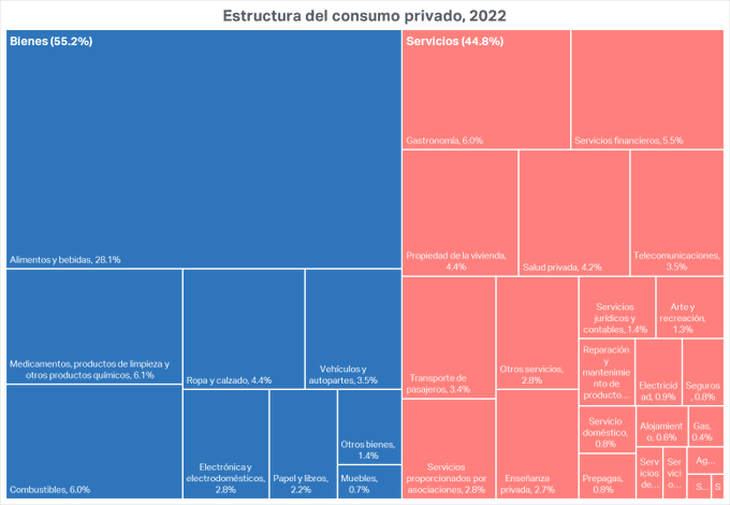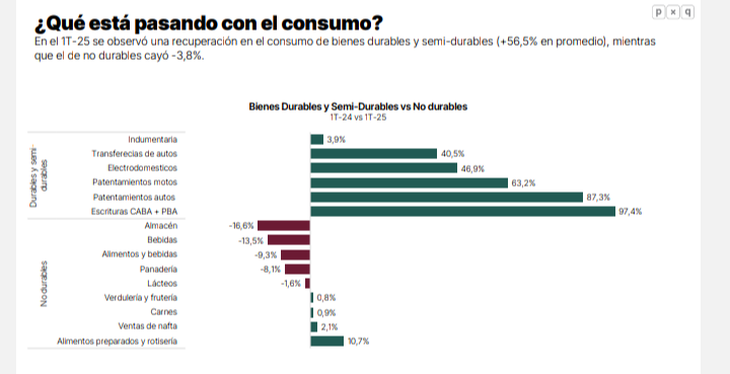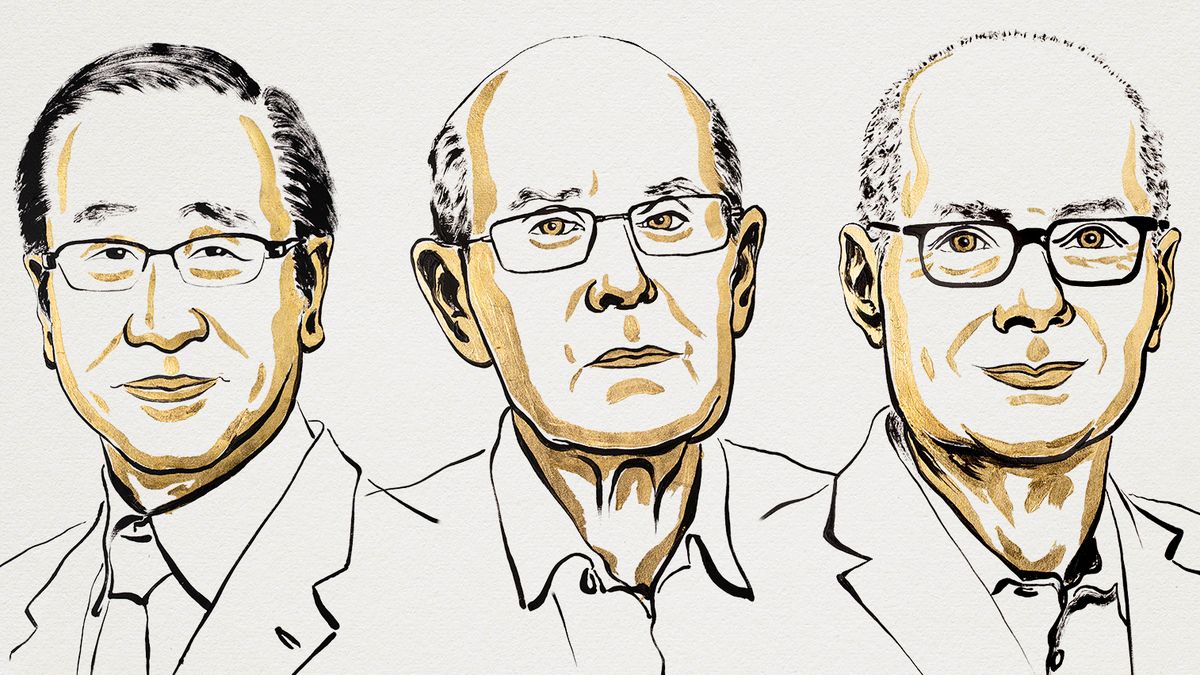First, it should be clarified that, In per capita terms, He failed to exceed the level of the first quarter of 2018 and was almost 2% below the maximum of 2013. On the other hand, it is also pertinent to inquire about the methodology used by INDEC to measure this variable.
image.png
According to national accounts, 55% of private consumption is made up of goods spendingamong which food (28%) stands out, followed by medications and chemicals, and fuels. The remaining 45% corresponds to serviceswith a much more couple distribution that mainly includes gastronomy, rentals, financial services, private health, telecommunications, transport, art, recreation, accommodation and public services.
Consumption Dany Scht.png

Source: @danyscht, based on INDEC.
Cheap dollar and commercial opening: two factors that explain record consumption
The economist Martín Carro held in dialogue with Scope That part of the surprise of the high figure has to do with which many people “starts thinking about which sectors the consumption of goods is so high”, but does not contemplate that The official public statistics agency measures the consumption of residents, which It includes, for example, the expenditure of Argentines on trips abroad or purchases by Amazon, transactions that do not have correlation in greater dynamism of local activity.
“In the same way, the foreign tourist who stopped buying tickets to go to El Calafate had its negative impact on the activity, but did not affect the consumption of residents, which went down were the exports of services,” he deepened.
In that sense, the teacher remarked that Exchange appreciation plays a key role When explaining the numbers that met on Monday. “In fact, the long -term chart resembles that of the real exchange rate (TCR) inverted,” he said.
Record consumption does not match a record, but with record imports. Between January and March, purchases abroad represented 32% of GDP, the highest value in 135 years.
Telechea.png consumption

That is why many specialists warn that much of the increase in this product component is generated by the growth of external purchases. In this regard, the economist Andrés Tavosnaska He underlined X that “the global demand in the last two years grew 5%, but 91% of that advance was supplied by the import rise.” “That is why we have consumption recovery without job generation”he warned.
Durable goods traction the improvement of consumption
In addition, Juan Graña, economist of the Paternal Group, explained that INDEC measures added consumption, without weight or averages, so the most expensive goods and services have greater influence. “If you buy one more Ferrari but 10,000 less noodles packages are bought, the consumption goes up”he stressed.
The analyst sees that “A high -income segment is enjoying the lowering of durable goods and tourism due to the overvaluation of the weight, and the rest is suffering the productive and social consequences of the economic model“. Therefore, it warns of consistency with the leaflet data of the labor market, which in the first quarter did not improve with respect to the first quarter of 2024 (the worst moment of the recession) and of wages, which in the private sector show signals of stagnation since the beginning 2025 (from a very low historical floor) and in the public sector they are well below the pre Milei levels.
“The destruction of registered jobs (such as the fall of state salary) are signs that affect the middle class,” he said.
PXQ.PNG consumption

According to a consultant’s report Moiguervariables linked to the evolution of the dollar, such as the sale of cars, the emissive tourism or the imports of consumer goods show accelerated growth, while, on the contrary, sales in supermarkets fell. This reflects, according to the entity’s perspective, a “Expansive profile” in consumption, fundamentally dollarized, of the population with medium-high income, but a continuous adjustment pattern in the rest of the “pesified” society.
Duality in consumption: a reflection of greater inequality?
Daniel SchteingartDirector of Productive Planning of Fundar, said that the rise in private consumption was, at least, of the largest amount of purchases of durable goods (such as cars, motorcycles or appliances) for credit, exchange appreciation and commercial opening, the tourism boom abroad and gradual recovery in food consumption
As of the hypothesis of a dynamic of consumption that deepens inequality, the sociologist was more cautioussince the coefficient of Gini (which measures inequality) had no major changes in 2024 and there was no evidence that the inflation of the poor has been higher than that of the rich.
Therefore, he suggested a different reading. It contemplates, on the one hand, that The consumption of durable goods grows both in high-income and medium-low income sectors. In parallel, he marked that to food consumption “is not going so bad As is derived from looking at supermarket sales, since there is evidence that in recent years the demand for food has been displaced towards other channels (specialized stores, deliverys, prepared or dietary meals, among others). “
On this issue, Car coincided since “there may be without increasing inequality by Gini (which measures flows) an increase in the acquisition of durable goods with accumulated stocks”, while “The purchasing power of the imported rose for all income deciles“
Even so, analysts note that all these hypotheses are debatable and that we must continue monitoring the dynamics. What is clear is that the INDEC record data is also to take it with “tweezers” and that the exchange and commercial policy of the government explains much of the current pattern of consumption.
Source: Ambito




